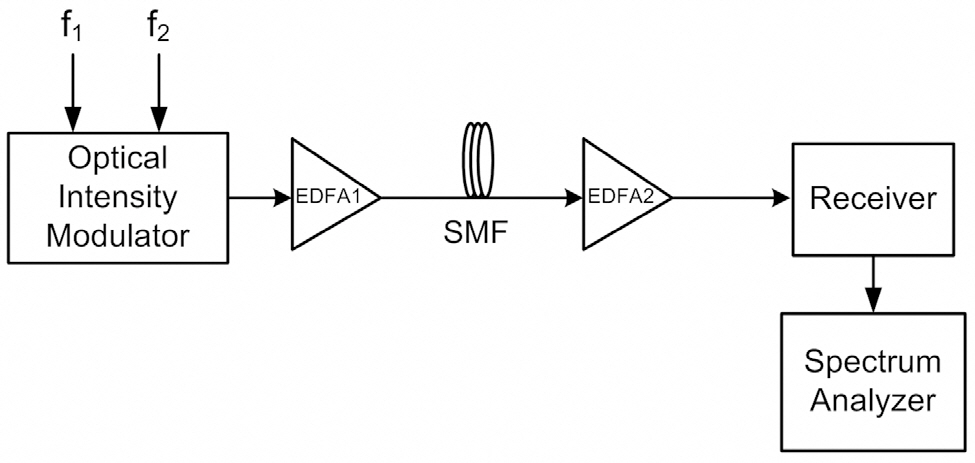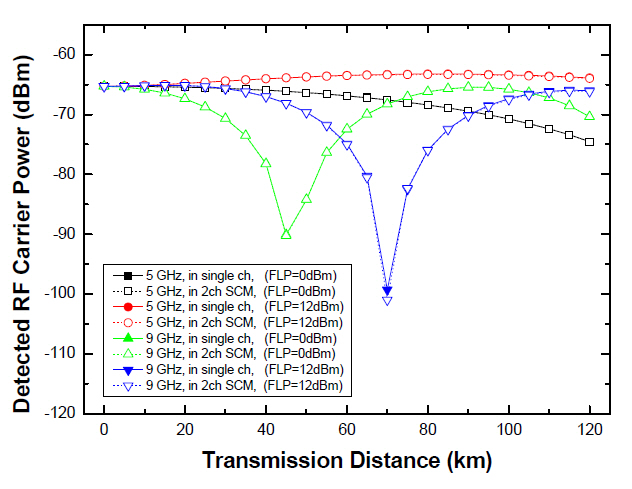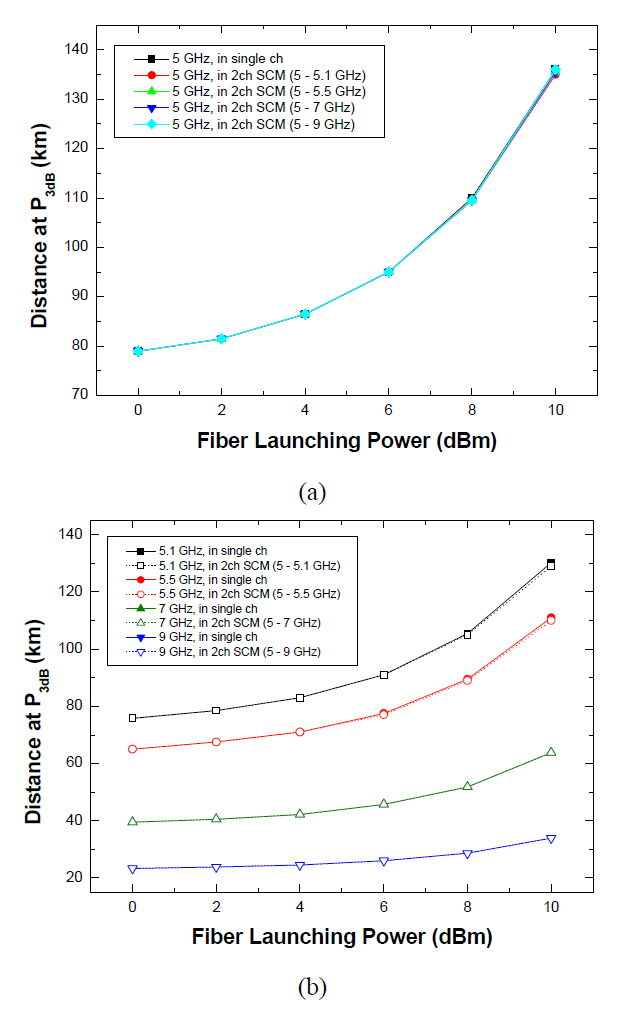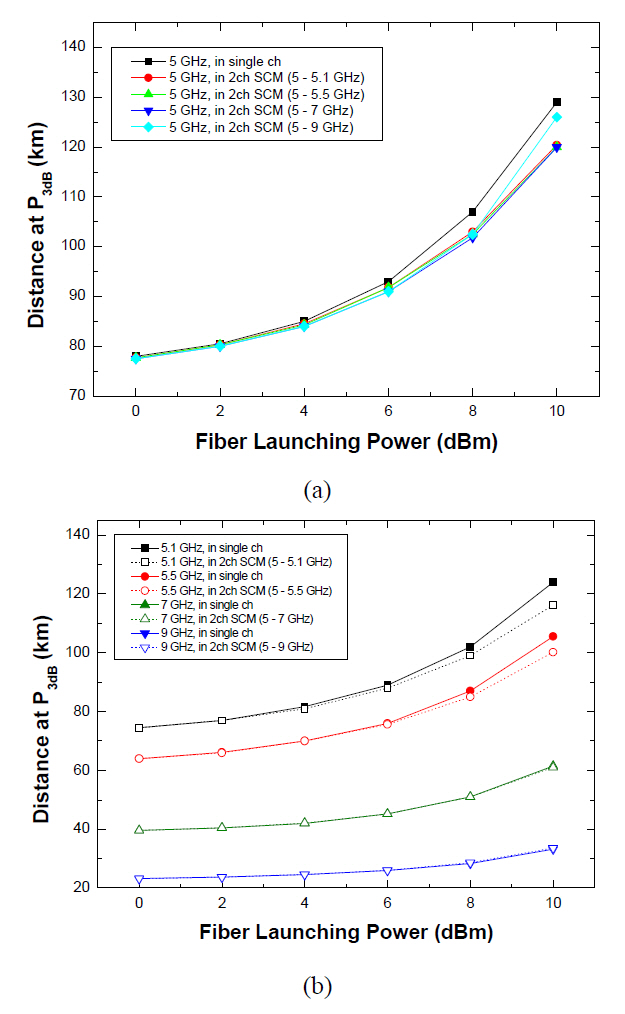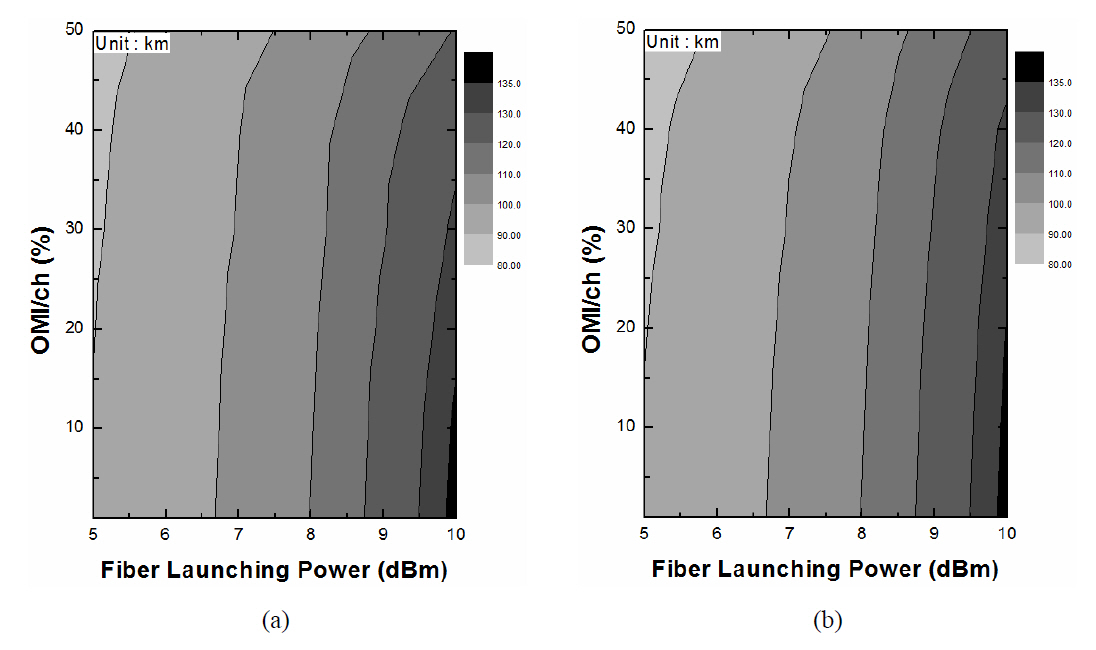



Radio over fiber (RoF) technology has received much interest in order to accommodate demands for increased bandwidth and diversity of services [1?2]. The advantage of RoF technology is the use of an optical fiber with low loss and wide bandwidth for signal transmission. The use of RoF technologies can reduce the size of radio base stations (RBSs) because each RBS needs only a device for optical-to-electrical conversion. Moreover, since the radio modulation unit is located at the control station (CS), the RBSs can use the same frequency band to transmit their radio signals.
RoF technology is often considered one of the simplest solutions to providing future wireless broadband access, and an RoF system including wireless communication systems has recently been proposed [3]. In multi-service environments,the transmission capacity and the number of users in a RoF network can be increased by using sub-carrier multiplexing(SCM) technology that enables multiple RF signals to be transmitted simultaneously over fiber-optic links.
However, when either the subcarrier frequency or the required transmission distance is large, the quality of the signal becomes degraded due to the impairment from the optical fiber channel such as the fiber nonlinearities [4] and the dispersion-induced power penalty (DIPP) that alters the first null point of the fiber transmission response dependent upon the subcarrier frequencies and transmission distance[5]. Although the self-phase modulation (SPM)-induced fiber dispersion compensation effect in millimeter-wave optical transmission systems has been investigated [6,7], the analysis has been limited to transmission systems with a single subcarrier. In this paper, we investigate, for the first time to our knowledge, the combined effect of fiber dispersion and SPM in multi-channel optical SCM transmission systems by theoretical analyses and numerical simulations.
We performed simulations of a two-channel SCM signal and calculated the RF power of the subcarrier signals under various SCM transmission environments, including the effects of fiber dispersion and SPM. From the simulated data, we investigate the effect of the optical modulation index (OMI),fiber launching power, and SCM channel spacing on the transmission of SCM signals.
The objective of this paper is to theoretically investigate the combined effect of fiber chromatic dispersion and SPM in optical multi-channel SCM transmission systems.The transmission distance at
Several studies on the feasibility of fiber-induced SPM to compensate for fiber dispersion effects have been reported[6,7]. For a single SCM channel, the nonlinear phase shift induced by SPM at a propagation distance z and normalized time in a frame moving at the group velocity,
with the field envelope at the fiber input,
For an SCM signal with two RF subcarrier channels(shown in Fig. 1), the initial pulse envelope and the nonlinear phase shift induced by SPM can be expressed as:
where
The field of the signal with a single RF subcarrier,considering solely the effect of SPM, can be expressed as:
and the field of SCM signal with two RF subcarrier channels, considering the initial pulse envelope and the phase shift due to SPM, is expressed as:
The last term in Eq. (4) describes the phase shift induced by the SPM effect. It is well known that, in single channel SCM transmission system, the SPM-induced frequency chirp can compensate for the pulse distortion due to chromatic dispersion in a single-mode fiber (SMF) [6,7].However, in two-channel SCM transmission system, there is additional phase shift caused due to the other SCM frequency
As shown in Fig. 1, the RF subcarrier signals were modulated by an optical linear modulator in order to observe the effect of fiber transmission. The lasing wavelength was 1550 nm, and the electrical RF subcarrier signals were sinusoids. For an optical signal propagating in a nonlinear, dispersive, and lossy single-mode fiber, the evolution of a slowly varying electric field pulse envelope can be found from the nonlinear Schrodinger equation [8]. We performed numerical simulations to examine the combined effect of fiber dispersion and SPM by using the split-step Fourier method [8,9]. In order to vary the strength of the SPM effect, the fiber launching power entering the SMF
[TABLE 1.] Parameters used in the numerical simulation.
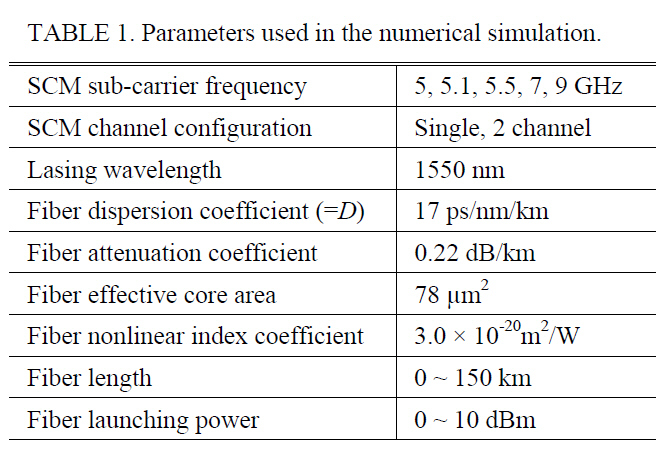
Parameters used in the numerical simulation.
was adjusted between 0 and 10 dBm using an optical amplifier before transmission. The length of the SMF was varied from 0 to 150 km in order to observe different fiber dispersion effects. We used the electrical power spectra calculated after detection with a photodiode to calculate the RF carrier power of each SCM channel. The specific parameters of the optical fiber link used in our simulations are shown in Table 1.
IV. NUMERICAL SIMULATION RESULTS
First, we simulated two-channel SCM transmission systems with a large channel spacing, and investigated the combined effect of fiber dispersion and SPM. Two subcarrier signals at 5 GHz and 9 GHz were combined. The OMI per channel was 20% and the detected RF carrier power for each channel was calculated after transmission over an SMF link up to 120 km. We also simulated SCM systems with a single subcarrier for comparison. Fig. 2 illustrates the detected RF carrier power for the single- and two-channel signals. Due to the DIPP characteristic, the null point of the carrier power fading as a function of the transmission distance appeared first for the 9 GHz signal [5]. When the higher fiber launching power (10 dBm) was applied, the transmission distance at the same detected RF carrier power was extended for 5 GHz and 9 GHz signals. This is due to the fact that the chirping effect of SPM combines with the fiber dispersion, leading to dispersion compensation in the SMF transmission link [6, 7].
However, the detected RF carrier powers for the singleand two-channel SCM signals were almost the same at the same subcarrier frequency and fiber launching power for all transmission distances. This is because the OMI per channel was relatively small and the channel spacing between the subcarrier channels was large. Therefore, there was little interaction between the subcarrier signals. The intermodulation product near two SCM channels was very small, even for an OMI per channel of 50%; therefore it can be expected that the effect of the nonlinear distortion after photo-detection in the receiver was also small.
We evaluated the transmission distances at which the detected RF carrier power dropped by 3 dB. These values are termed the “transmission distance at
Fig. 3(a) shows the transmission distance at
values were almost the same for the single- and two-channel configurations, even for different SCM channel allocations.Fig. 3(b) shows the transmission distance at
Fig. 4(a) shows the transmission distance at
sation effect. However, the two-channel system showed a drop in the transmission distance at
From the analysis in Section 2, when the SCM signals have large OMI per channel and the channel spacing is small, the effect of the additional phase shift term in Eq.(5) is more pronounced. Therefore, the performance improvement due to the interaction between fiber dispersion and SPM can be reduced at high fiber launching powers.
Fig. 5(a) and (b) show the contour plots of the transmission distance at
spacing of 100 MHz, as shown in Fig. 5(a), is degraded especially in the higher fiber launching power because the increased interaction between subcarrier signals can reduce the effect of SPM-induced fiber dispersion compensation.For example, when the OMI of 40% and the fiber launching power of 10 dBm are applied in the system, the SCM system with 100 MHz channel spacing (Fig. 5(a)) cannot guarantee the transmission distance at
We investigated the combined effect of fiber dispersion and SPM in optical SCM transmission systems. From a theoretical analysis and numerical simulations, we found that the dispersion compensation effect in combination with SPM occurred independently for each subcarrier for a small OMI per channel and large channel spacing.
We evaluated the performance of single-channel and two-channel SCM systems in terms of the transmission distances at
